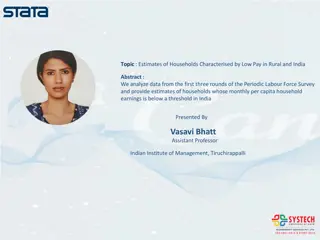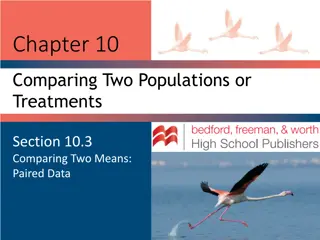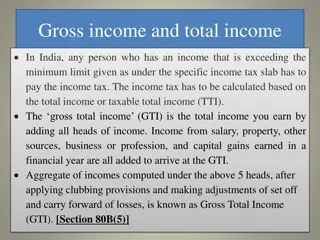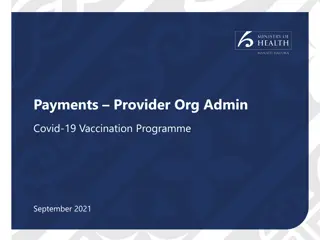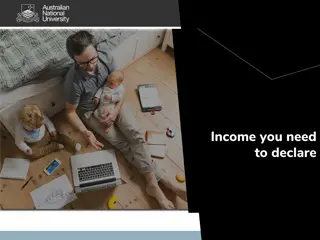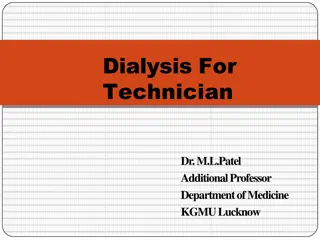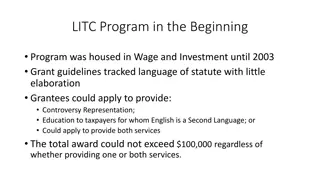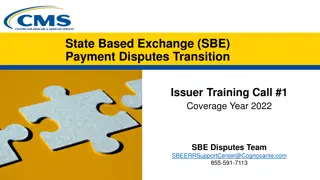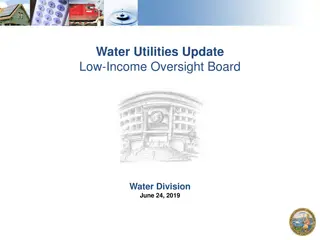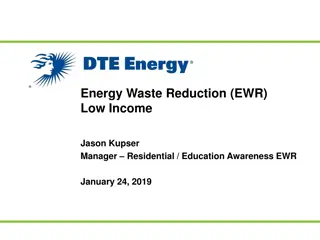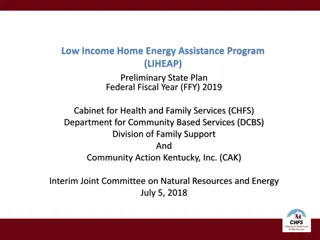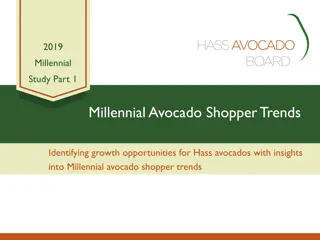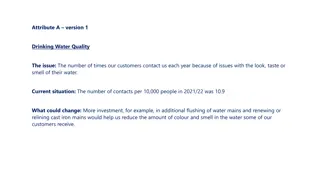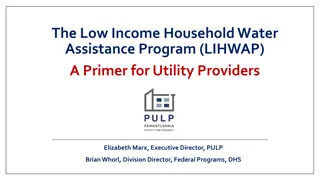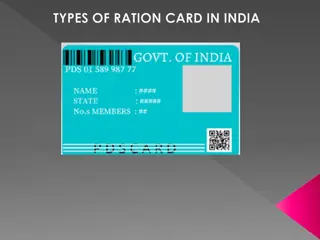Payment Modalities for Low-Income Households: Accelerating Access to Water
This study examines payment modalities to enhance water access for low-income households. It explores strategies to promote on-premise water supply in underserved communities, highlighting the importance of inclusive financial schemes.
Download Presentation

Please find below an Image/Link to download the presentation.
The content on the website is provided AS IS for your information and personal use only. It may not be sold, licensed, or shared on other websites without obtaining consent from the author.If you encounter any issues during the download, it is possible that the publisher has removed the file from their server.
You are allowed to download the files provided on this website for personal or commercial use, subject to the condition that they are used lawfully. All files are the property of their respective owners.
The content on the website is provided AS IS for your information and personal use only. It may not be sold, licensed, or shared on other websites without obtaining consent from the author.
E N D
Presentation Transcript
Stef Smits and Lemessa Mekonta Payment modalities for low-income households A key element for accelerating access to water on premise
Background Much research on affordability of services; less on how payment modalities affects access to services Context Country Project name Utility service expansion to low income areas Ethiopia Source to tap and back Kenya Performance enhancement of water utilities in Kenya through benchmarking, collective learning and innovative financing (PEWAK) Mozambique Sustainable Water Services Beira The way in which users do the payment for 1) capital costs, 2) connection fees and 3) user charges to the service providers, described by factors of: One-off payment or in instalments The timing of payment: pre-paid, pay-as- you-fetch, or post-payment The frequency of payment Presence of intermediaries Volumetric vs flat rate payment Means of transaction. In-kind, in-labour, in-cash, or mobile payment The Philippines Sustainable and Resilient Pro-poor Water Supply Project in Cebu Rwanda Scaling universal access to safe and climate resilient water services in Rwanda Uganda Alternative Approaches and Tools for Improved Water Supply and Sanitation for Towns in Northern Uganda Newly established water systems with private operator Benin Water Entrepreneurs Project Ghana Public-Private Partnership for Water in Ghana Mali Sustainable O&M model for manual pumps in Mali; the UDUMA concept Water filters Ethiopia Safe Drinking Water for Ethiopia Review of such modalities across 10 projects, in contexts of utilities and private operators
Findings Payment modalities for connection costs Upfront payment of cost-reflective fee: Standard, but restrictive, practice paying to enter the water shop (Franceys and Gerlach, 2006) Payment of cost-reflective connection fee in instalments Highly effective, as witnessed in statistics of uptake of the measure Low cost to the service provider Easy to implement, not requiring advanced supporting systems Upfront payment of non-cost reflective connection fee (social connection fee): Improves affordability, but doesn t reduce cash-flow concerns Equitable as based on cross-subsidies between existing and new users, but requiring information on socio- economic status
Findings Payment modalities for user charges Large number of modalities found on the basis of combinations between: timing/frequency, presence of intermediary, flat rate vs volumetric, and means of transaction Not one single most effective frequency/timing; important to try out considering advantages and disadvantages For low-income customers, alignment between frequency of payment and cash-flow is key, more than whether it is pre- or post-payment Advantages Users can align to their cash flow Avoids building up large bills Arrears are close to zero Low transaction costs Disadvantages No access if credit is used up Reduced water usage Higher upfront costs of prepaid meters Pre-paid Post-payment High-frequency aligns with cash flow of users High transaction costs Requires widespread availability of payment locations
Findings Payment modalities for user charges Household connections reduce the need for charging via intermediaries which is common for stand pipes: Needed as utilities are often not able to connect all low-income households Drawbacks and risks of additional cost of having and abuse of position Though hybrid/mobile means of transaction offers advantages, effectiveness depends on: Overall presence and reliability of mobile money payment systems Alignment with other existing payment systems Shifts over time
Findings Supporting technical, social and institutional systems Enabled by developments in ICT: electronic water meters, pre- payment devices, electronic ledgers Process of piloting, testing and selecting Criteria of: costs, compatibility and interoperability with other software of service provider uses, the maintenance of ICT devices, offline performance, ease of use Institutional relations, particularly where intermediaries are used Social measures, particularly: studies into affordability and preferences for payment, awareness raising and monitoring payment and water use Regulation and policies, specifically broader pro-poor policies
Conclusions Barriers for low-income households of getting access to be kept as low as possible If connection fee is due, this should be spread out over time, and payable in instalments As important as affordability is alignment of the payment modality with cashflow ICT developments enabling diversity in payment modalities that allow alignment (either pre-paid or high-frequency post-payment) At the same time, helping to reduce commercial losses and dependency on intermediaries. Risks of reduced water consumption or not accessing improved supplies at all. No one single best (or worst) payment modality - rather the importance of process measures to define and adjust modalities: Social-economic and market studies upfront Adjusting payment modalities based on insights from monitoring data Piloting ICT options Embedding in pro-poor policies


